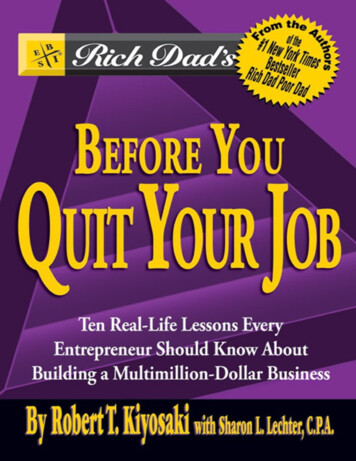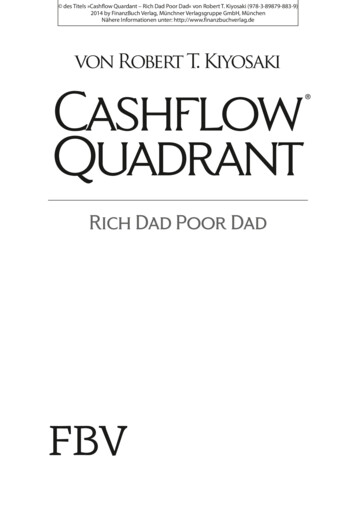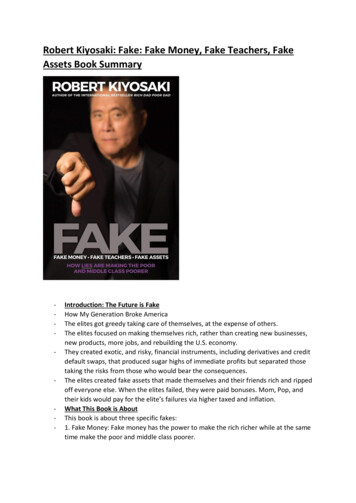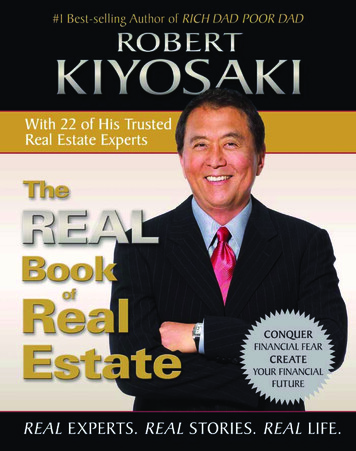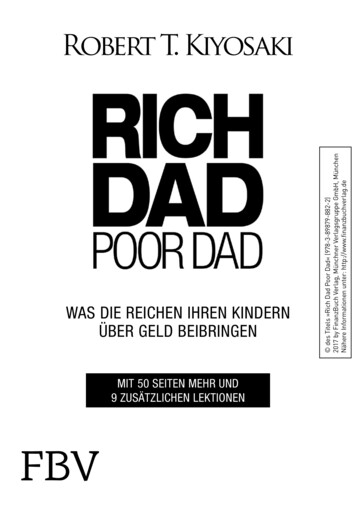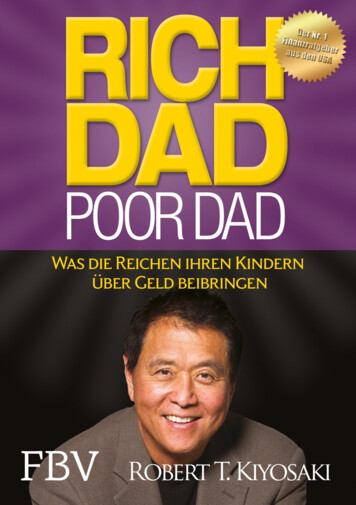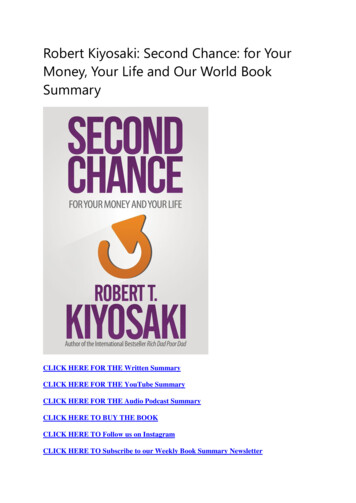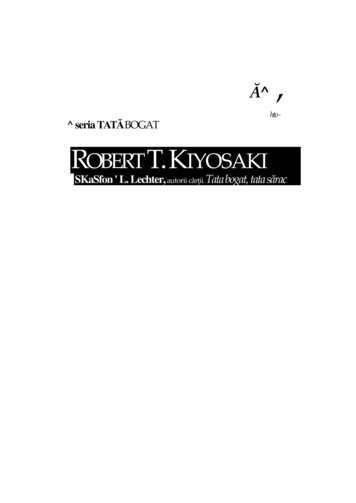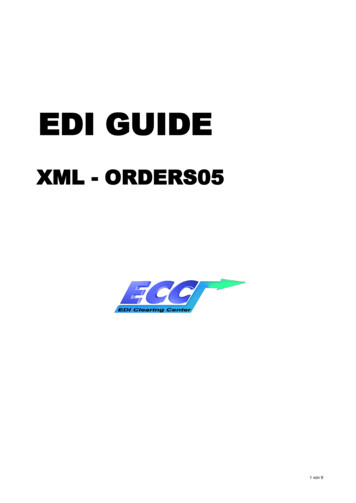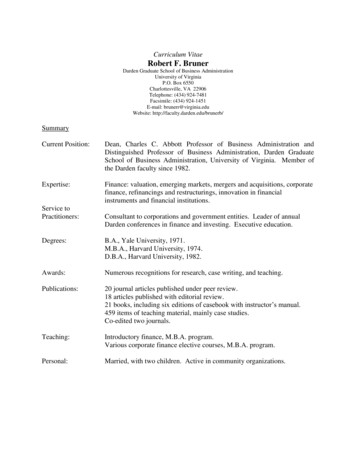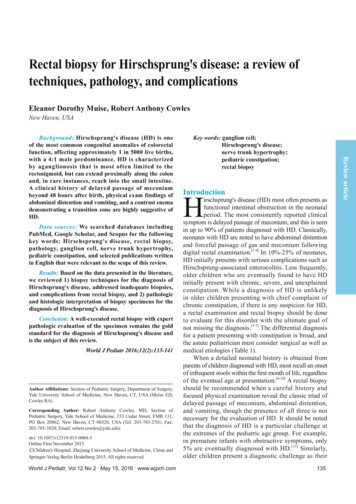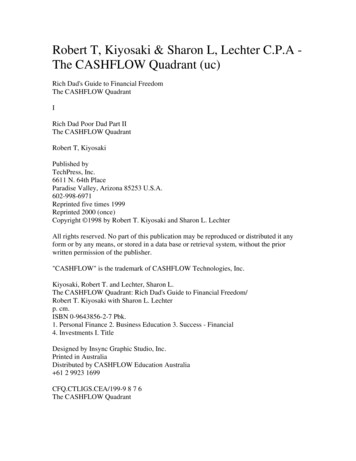
Transcription
Robert T, Kiyosaki & Sharon L, Lechter C.P.A The CASHFLOW Quadrant (uc)Rich Dad's Guide to Financial FreedomThe CASHFLOW QuadrantIRich Dad Poor Dad Part IIThe CASHFLOW QuadrantRobert T, KiyosakiPublished byTechPress, Inc.6611 N. 64th PlaceParadise Valley, Arizona 85253 U.S.A.602-998-6971Reprinted five times 1999Reprinted 2000 (once)Copyright 1998 by Robert T. Kiyosaki and Sharon L. LechterAll rights reserved. No part of this publication may be reproduced or distributed it anyform or by any means, or stored in a data base or retrieval system, without the priorwritten permission of the publisher."CASHFLOW" is the trademark of CASHFLOW Technologies, Inc.Kiyosaki, Robert T. and Lechter, Sharon L.The CASHFLOW Quadrant: Rich Dad's Guide to Financial Freedom/Robert T. Kiyosaki with Sharon L. Lechterp. cm.ISBN 0-9643856-2-7 Pbk.1. Personal Finance 2. Business Education 3. Success - Financial4. Investments I. TitleDesigned by Insync Graphic Studio, Inc.Printed in AustraliaDistributed by CASHFLOW Education Australia 61 2 9923 1699CFQ.CTLIGS.CEA/199-9 8 7 6The CASHFLOW Quadrant
BOOK DEDICATION'Man is born free;and everywhere he is in chains.One thinks himself the master of others,and still remains a greater slave than they. "Jean Jacques RousseauMy rich dad used to say, "You can never have true freedom without financial freedom."He would go onto say, "Freedom may be free, but it has a price.” This book is dedicatedto those people willing to pay the price. CASHFLOW QuadrantTo Our Friends,The phenomenal success of Rich Dad Poor Dad has brought us thousands new friends allover the world. Their kind words and friendship inspired us to write be CASHFLOWQuadrant which, in reality, is a continuation of Rich Dad Poor Dad.So to our friends, old and new, for their enthusiastic support beyond our wildest dreams,we say thank you.CASHFLOW QuadrantTable of ContentsIntroductionChapter OneChapter TwoChapter ThreeChapter FourChapter FiveChapter SixChapter SevenChapter FightChapter NinePart IIIChapter FifteenChapter SixteenChapter Seventeen
Chapter EighteenChapter enChapter ElevenChapter TwelveChapter ThirteenChapter FourteenWhich Quadrant Are You In?Is It The Right One For You?The Cashflow Quadrant"Why Don't You Get A job?7Different Quadrants Different People17Why People Choose Security Over Freedom3 Kinds Of Business SystemsThe 7 Levels Of InvestorYou Cannot See Money With Your Eyes47698197Bringing Out The Best In YouBecoming Who You Are .How Do I Get Rich? .Be The Bank. Not The BankerHow To Be A Successful 'B" and "rTake Baby Steps .THE 7 STEPS TO FIADINGYOUR FINANCIAL FAST TRACKStep 1: It's Time To Mind Your Own Business. .Step 2: Take Control Of Your Cash Flow199203Step 3: Know The Difference Between Risk And Risky .Step 4: Decide What Kind Of InvestorYou Want To Be .Step 5: Seek MentorsStep 6: Make Disappointment Your Strength .Step 7: The Power Of FaithIn SummaryThe Quick Reference Guide to Wealth231
INTRODUCTIONWork QuadrantAre You In? Is It THE Right One For You?Are you financially free? The CASHFLOW Quadrant was written for you if yourlife has come to a financial fork in the road. If you want to take control ofwhat youdo today in order to change your financial destiny it will help you chartyourcourse. This is the CASHFLOW Quadrant1 -1 The letters in eachquadrant represent:E for employeeS for self-employedB for business ownerI for investorThe Cashflow QuadrantEach of us resides in at least one of the four quadrants of the CASHFLOWQuadrant. Where we are is determined by where our cash comes from. Many of us relyon paychecks and are therefore employees, while others are self-employed.Employees and self-employed individuals reside on the left side of theCASHROW Quadrant. The right side of the CASHFLOW Quadrant is for individualswho receive their cash from businesses they own or investments they own.The CASHFLOW Quadrant is about the four different types of people who makeup the world of business, who they are and what makes individuals in each quadrantunique. It will help you define where you are in the Quadrant today and help you chart acourse for where you want to be in the future as you choose your own path to financialfreedom, while financial freedom can be found in all four of the quadrants, the skills of a"B" or "I" will help you reach your financial goals more quickly. A successful "E" shouldalso become a successful "I".WHAT DO YOU WANT TO BE WHEN YOU GROW UP?This book is in many ways Part 11 of my book, Rich Dad Poor Dad For those ofyou who may not have read Rich Dad Poor Dad, it was about the different lessons mytwo dads taught me about the subject of money and life choices. One was my real dadand the other my best friend's dad. One was highly educated and the other a high schooldrop out. One was poor and the other rich. Whenever I was asked the question, "What doyou want to be when you grow up?
My highly educated but poor dad -always recommended, "Go to school, get good grades,and then find a safe secure job." fie was recommending a life's path that looked like this.SCHOOLPoor Dad W Advicethe Cashflow QuadrantPoor dad was recommending that I choose to become either a high paid "E",employee, or a high paid "S", self employed professional, such as a medical doctor,lawyer, or accountant. My poor dad was very concerned about a steady paycheck,benefits, and job security. That is why he was a high paid government official; the headof education for the State of Hawaii.My rich, but uneducated dad on the other hand offered very different advice.He recommended: "Go to school, graduate, build businesses and become a successfulinvestor. He was recommending a life that looked like this.Rich Dad's AdviceSCHOOL --This book is about the mental, emotional, and educational process I went through infollowing my rich dad's advice.WHO THIS BOOK IS FORThis book is written for people who are ready to change quadrants. This book isespecially for individuals who are currently in the "E" and "S" categories and arecontemplating becoming "B's" or "I's". It is for people who are ready to move beyond jobsecurity and begin to achieve financial security. It is not an easy life's path but the prize atthe end of the journey is worth the journey. It is theRich dad told me a simple story when I was 12 years old that has guided me togreat wealth and financial freedom. It was rich dad's way of explaining the differencebetween the left side of the CASHFLOW Quadrant, the "E" and The CASHFLOWQuadrantquadrants, from the right side or the "B" and "I" quadrants. It goes:"Once upon a time there was this quaint little village. It was a great place to liveexcept for one problem. The village had no water unless it rained. To solve this problemonce and for all, the village elders decided to put out to bid the contract to have waterdelivered to the village on a daily basis. Two people volunteered to take on the task andthe elders awarded the contract to both of them. They felt that a little competition wouldkeep prices low and insure a back up supply of water.The first of the two people who won the contract, Ed, immediately ran out, boughttwo galvanized steel buckets and began running back and forth along the trail to the lakewhich was a mile away. He immediately began making money as he labored morning todusk hauling water from the lake with his two buckets. He would empty them into thelarge concrete holding tank the village had built. Each morning he had to get up beforethe rest of the village awoke to make sure there was enough water for the village when it
wanted it. It was hard work, but he was very happy to be making money and for havingone of the two exclusive contract for this business.The second winning contractor, Bill, disappeared for a while. He was not see formonths, which made Ed very happy since he had no competition. Ed was making all themoney.Instead of buying two buckets to compete with Ed, Bill had written a businessplan, created a corporation, found four investors, employed a president to do work, andreturned six months later -with a construction crew. Within a year his team had built alarge volume stainless steel pipeline which connected the village to the lake.At the grand opening celebration, Bill announced that his water was cleaner thanEd's water. Bill knew that there had been complaints about dirt in Ed's water, Bill alsoannounced that he could supply the village with water 24 hours a day, 7 days a week. Edcould only deliver water on the weekdays . he did not work on weekends. Then Billannounced that he would charge 75% less than Ed did for higher quality and morereliable source of water. The village cheered and ran immediately for the faucet at the endof Bill's pipeline.In order to compete, Ed immediately lowered his rates by 75%, bought two morebuckets, added covers to his buckets and began hauling four buckets each trip. In order toprovide better service, he hired his two sons to give him a hand for the night shift and onweekends. When his boys went off to college, he said them,'Hurry back because someday this business will belong to you.'The CASHFLOW QuadrantFor some reason, after college, his two sons never returned. Eventually Ed hademployees and union problems. The union was demanding higher wages, better benefits,and wanted its members to only haul one bucket at a time.Bill, on the other hand, realized that if this village needed water then othervillages must need water too. He rewrote his business plan and went off to sell his highspeed, high volume, low cost, and clean water delivery system to villages throughout theworld. He only makes a penny per bucket of water delivered, but he delivers billions ofbuckets of water everyday, regardless if he works or not, and all that money pours intohis bank account. Bill had developed a pipeline to deliver money to himself as well aswater to the villages.Bill lived happily ever after and Ed worked hard for the rest of his life and hadEach there he was contractsot seenasusinessdo thear hisvillageleanerIs water.day, 7
rk onid for thisrantwots eacha handhe said tofinancial problems forever after. The end."That story about Bill and Ed has guided me for years. It has assisted me inmylie's decision making process. I often ask myself,"Am I building a pipeline or hauling buckets?""Am I working hard or am I working smart?"And the answers to those questions have made me financially free.And that is what this book is about. It is about what it takes to become a"B"and an "I". it is for people who are tired of hauling buckets and are readyto buildpipelines for cash to flow into their pockets. not out of their pockets.This book is divided into three pails.Part One: The first part of this book is about the core differences betweenpeople in the four quadrants. It is about why certain people gravitate tocertainquadrants and often get stuck there without realizing it. It will help youidentifywhere you are today in the Quadrant and where you want to be in five years.Part Two: The second part of this book is about personal change. It ismoreabout "who" you have to be instead of what you have to do.Part Three: The third part of this book defines seven steps you can take onyour path to the right side of the Quadrant. I will share more of my richdad'ssecrets on the skills required to be a successful "B" and "I". It will helpyou chooseyour own path to financial freedom.Throughout The CASHFLOW Quadrant I continue to stress theimportance offinancial intelligence. if you want to operate on the right side of thequadrant, the"B" and "I" side, a person needs to be smarter than if you choose to stayon the leftside as an "E" or 'IS".
To be a "B" or "I", you must be able to control the direction your cashflow isThe CASHFLOW Quadrantflowing. This book is written for people who are ready to make changes intheirlives. It is written for people who are ready to move beyond job securityandbegin to build their own pipelines to achieve financial freedom.We are in the dawning of the information Age and this age will offer moreopportunities than ever before for financial reward. It will be individualswiththe skills of the "B's" and "Ps" who will be able to identify and seizethoseopportunities. To be successful in the Information Age, a person will needinformation from all four quadrants. Unfortunately, our schools are stillin theIndustrial Age and still prepare students for only the left side of theQuadrant.if you are looking for new answers to move forward into the InformationAgethen this book is written for you. It is written to assist you in yourjourney intoInformation Age. It does not have all the answers . but it will share thedeeppersonal and guiding insights I gained as I traveled from the "E" and "S"side of theCASHFLOW Quadrant, to the "B" and "I" side.If you are ready to begin your journey or are already on your journeyfinancial freedom this book is written for you.As my way of saying ''Thank You" for reading this book and increasingyourknowledge aboutmoney and business, I make available to you an audio cassette tape entitled,""at My Rich Dad TaughtMe About Investing.It is an educational tape that offers further insights into what my richdad taught me aboutinvesting. It is offered to further enhance your education and explain, whywe create our education,products for people like you. With a retail value of 19.95 we offer thistape as a gift to you.
This tape does not discuss what I call "Middle Class" investmentstrategies. especially thoseheavily dependent upon mutual funds. In fact you will find out why manyrich people don't buymutual funds. As with all our products, we do our best to providedistinctions between how the rich andthe poor, and the middle class think. and then leave the choice up to youas to which way youwant to think. After all, one of the benefits of living in a free societyis that we all have the choicebe rich, poor, or middle class. Tha
Robert T, Kiyosaki & Sharon L, Lechter C.P.A - The CASHFLOW Quadrant (uc) Rich Dad's Guide to Financial Freedom The CASHFLOW Quadrant I Rich Dad Poor Dad Part II The CASHFLOW Quadrant Robert T, Kiyosaki Published by TechPress, Inc. 6611 N. 64th Place Paradise Valley, Arizona 85253 U.S.A. 602-998-6971 Reprinted five times 1999
